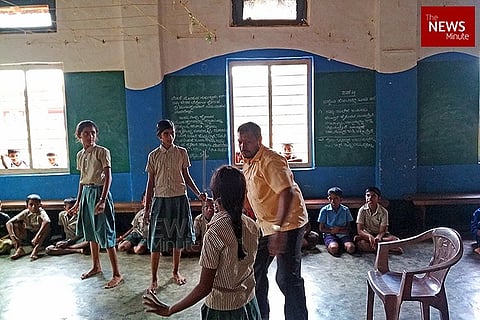

Every now and then, we come across a teacher who goes beyond the call of duty for their students. 'Teachers Who Transform' is TNM's five-part series, honouring the teachers who go the extra mile to understand their students, their unique needs and difficulties, and provide them with education that goes beyond academics. This is the third story in the series.
The teachers at the Government Primary School at Heskathur in Udupi have more than the usual set of responsibilities. "Doing it this way, there is more workload for the teachers but we can see the benefits among our students so we want to continue it," says Jayalakshmi, a teacher at the school.
The seven teachers at the school implemented a novel system of learning which includes setting up classrooms in the school specifically for each subject, running a monthly newspaper written by the students among other engaging activities.
The system which was put in place gradually over the last seven years, has begun to pay dividends as the number of students in the school shot up from 162 to 195 this year, at a time when the strength of students at nearby government-run schools dwindled down to the 60-70. "The numbers have come down in all the nearby schools but in spite of our school being a Kannada medium school, students have begun coming in from as far as 15 km away," says Jayalakshmi.
Jayalakshmi puts the upsurge in admissions at the school down to a number of factors. Learning in the school is infused with a mix of activities which are encouraged by the teachers. In fact, the students of classes 1, 2 and 3 are grouped together and are taught by the 'Nali Kali' system.
Harusha, a student studying in class 3, and Srajjan, a student studying in class 3, are inseparable in school. "There are 85 students in class 1, 2 and 3 and we have put them all together in three sections. In each section, there are students of all three classes," explains Jayalakshmi.
The students are grouped together for the first three years when they are learning their basics and the students graduate to the next class only when they have sufficiently learned the topics they are being taught " No student is forced to learn. Once a student has grasped the concepts, they move onto the next one and so on. This ensures that students learn basic concepts at their own pace," adds Jayalakshmi.
The teachers have also taken the initiative to build separate classrooms for each subject. "We have a separate English classroom, Science classroom and Math classroom. The way it works is an English classroom will have an environment to study English including the materials and supporting materials needed to study English. Due to this, they are moving about all day and are lively. When they go to the classroom, their mindset is also completely focused on the particular subject," explains Ashok Thekkatte, a teacher at the school.
Each classroom has charts hanging from the ceiling with information related to the particular subject. The English classroom in the school is filled with charts containing commonly used words, famous rhymes and phrases used in everyday conversations. It also included a mini library, board games like Scrabble and comics like Champak and Tinkle. "Just pasting them on the walls of the classroom is not enough. The teachers consciously make use of the charts and hangings while teaching our lessons," says Ashok.
The students are also tasked with maintaining a monthly newspaper 'Namma Inchara', complete with articles and poems written by them, which is circulated in the village. "We want the community to be involved and updated with the education of their children," says Ashok. The students are also taught art forms including Yakshagana and Bharatanatyam every week.
Even though the school prides itself as a Kannada medium school, the teachers say that they want to strike a healthy balance between Kannada and English. " We don’t want to make this an English medium school. If topics are learnt in the mother tongue, then it is understood well. But we can't neglect English either. It is a necessary language and we should definitely strengthen the student's ability to read, write and speak English but that does not mean Science and Maths should also be taught in English," says Ashok
The school authorities have also tied up with Field Services and Inter-Cultural Learning (FSL India) by which a visiting teacher from abroad teaches English at the school. Beatrix Rosseger, who arrived in Heskathur in August, is set to be the English teacher in the school for the current academic year. "I try to teach the language in various ways. It involves playing games that help the children remember words and improve their grammar. The students help each other and take part in the lessons," she says.
The reputation of the school is growing and students from as far as 15 km away are now enrolled at Government Primary School in Heskathur. The initiatives put in place by the teachers at this school has seen it grow from strength to strength even as government schools in nearby villages reported a fall in the number of students. "There is no compulsion from the government that we should be teaching this way but by doing this, the strength of our school increased. There are spoken English classes here and the teachers include innovative activities in the lessons and children from as far as 10-15 km come to our school. We hope to continue the functioning of the school in the same way," says Shekhar Kumar, the school's headmaster.
Read the other stories in 'Teachers Who Transform' here: